L62-陈述或疑问句式 初中英语词性句法新讲课件
文档属性
| 名称 | L62-陈述或疑问句式 初中英语词性句法新讲课件 | 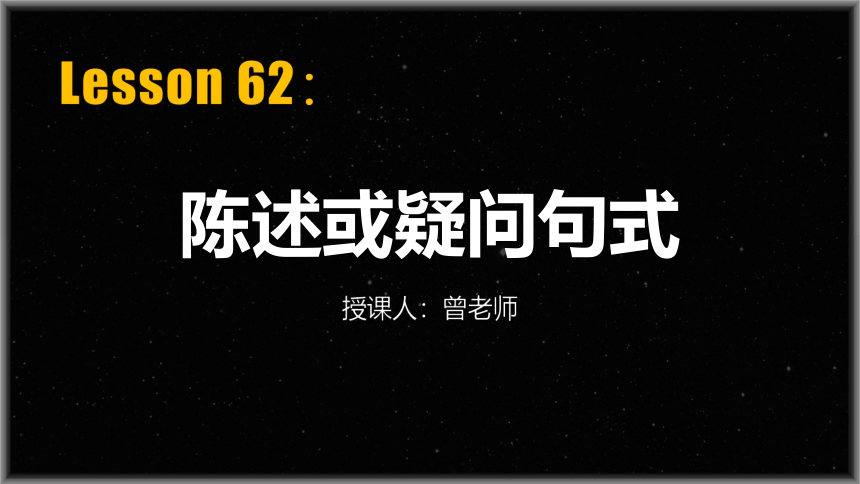 | |
| 格式 | ppt | ||
| 文件大小 | 1.1MB | ||
| 资源类型 | 试卷 | ||
| 版本资源 | 通用版 | ||
| 科目 | 英语 | ||
| 更新时间 | 2022-04-11 09:59:54 | ||
图片预览

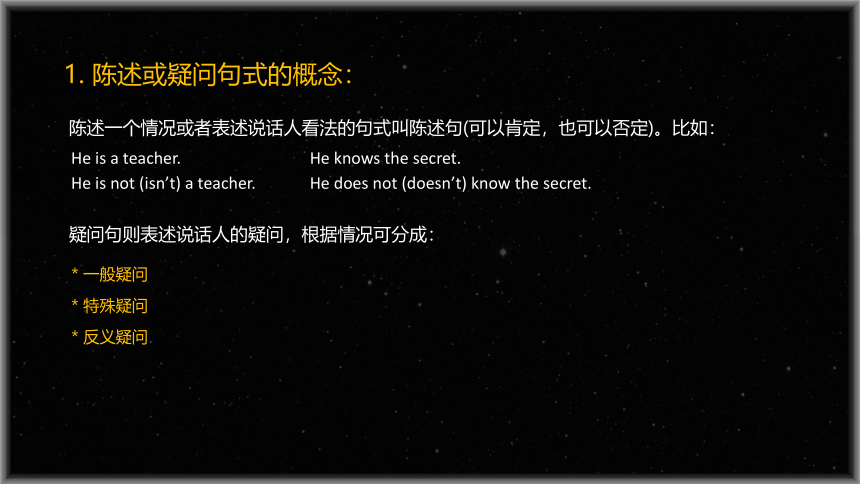
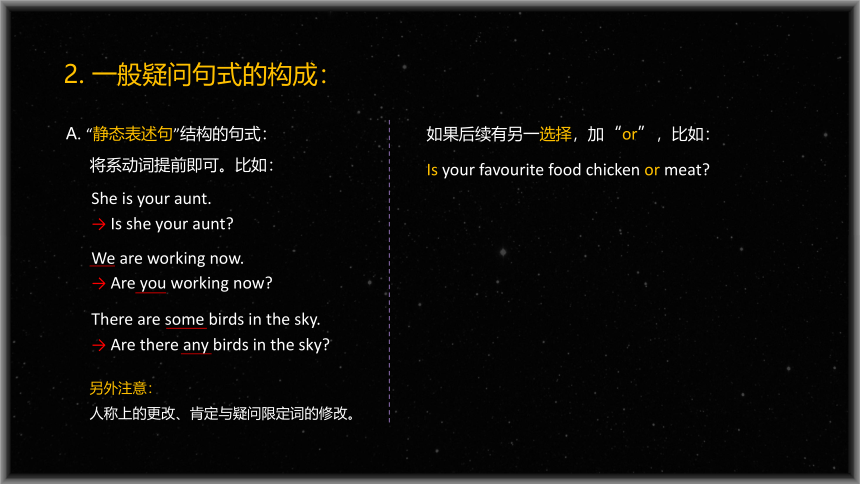
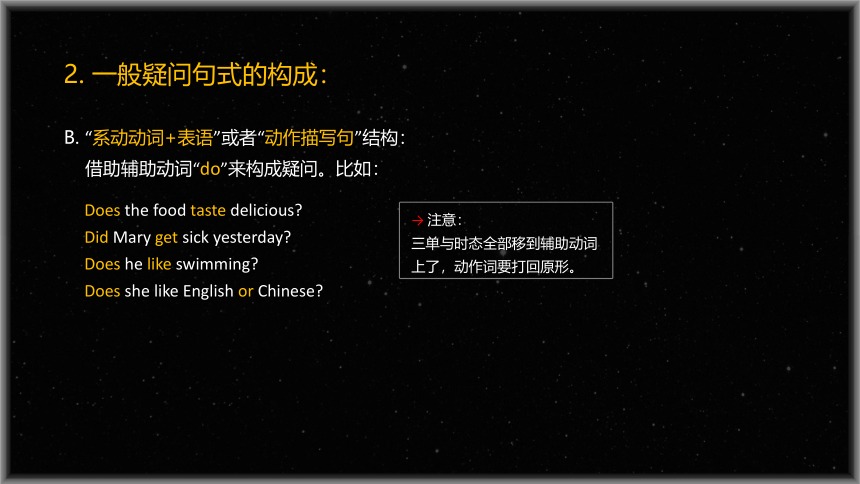
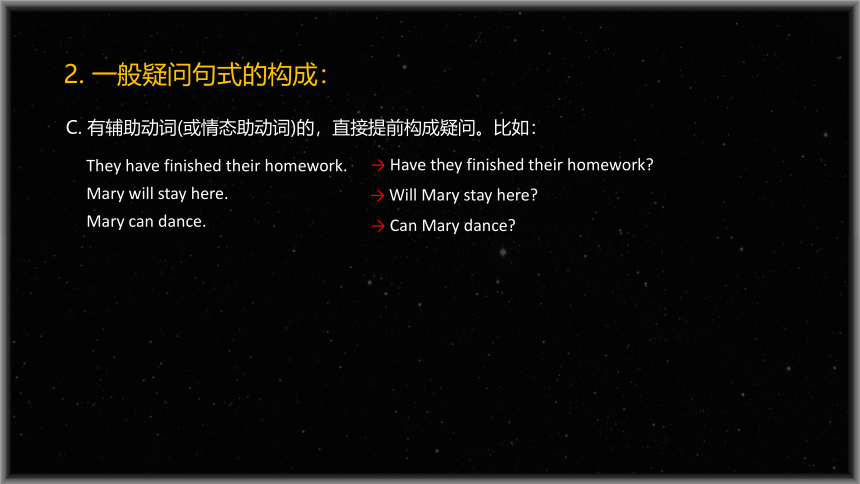

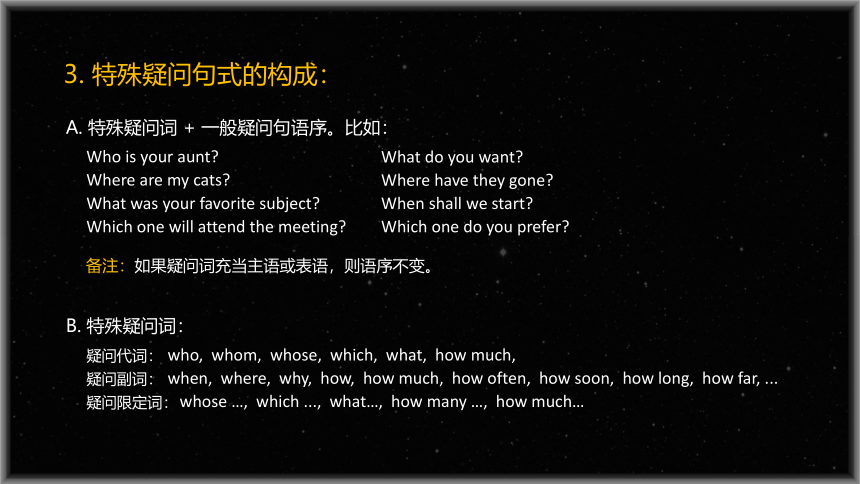
文档简介
(共16张PPT)
陈述或疑问句式
Lesson 62:
授课人:曾老师
1. 陈述或疑问句式的概念:
陈述一个情况或者表述说话人看法的句式叫陈述句(可以肯定,也可以否定)。比如:
He is a teacher.
He is not (isn’t) a teacher.
He knows the secret.
He does not (doesn’t) know the secret.
疑问句则表述说话人的疑问,根据情况可分成:
* 一般疑问
* 特殊疑问
* 反义疑问
2. 一般疑问句式的构成:
A. “静态表述句”结构的句式:
将系动词提前即可。比如:
如果后续有另一选择,加“or”,比如:
Is your favourite food chicken or meat
→ Is she your aunt
→ Are you working now
We are working now.
There are some birds in the sky.
→ Are there any birds in the sky
She is your aunt.
另外注意:
人称上的更改、肯定与疑问限定词的修改。
2. 一般疑问句式的构成:
B. “系动动词+表语”或者“动作描写句”结构:
借助辅助动词“do”来构成疑问。比如:
Does the food taste delicious
Did Mary get sick yesterday
Does he like swimming
Does she like English or Chinese
→ 注意:
三单与时态全部移到辅助动词
上了,动作词要打回原形。
2. 一般疑问句式的构成:
C. 有辅助动词(或情态助动词)的,直接提前构成疑问。比如:
They have finished their homework.
Mary will stay here.
Mary can dance.
→ Have they finished their homework
→ Will Mary stay here
→ Can Mary dance
“some”与“any”的区别:
“some”表示数或量上“有一些”,常用于肯定句中。不在数量多少上有疑问时也可用于疑问句。
比如:Would you like some water What about some fruit juice
“any”常用于疑问或否定句中,表示数与量上“有那么任何一个或哪怕任何一点(一些)”。
也可用于肯定句表“任何一个/一些…” 。比如:
Do you have got some water Can I buy any from you
Do you have got any water Can I get some from you
→ 有水吗 哪怕卖给我一丁点也行。
→ 有没有那么一丁点水 请给我一些。
Any student can answer this question.
He never had any regular schooling.
I can answer your question without any hesitation.
3. 特殊疑问句式的构成:
A. 特殊疑问词 + 一般疑问句语序。比如:
Who is your aunt
Where are my cats
What was your favorite subject
Which one will attend the meeting
What do you want
Where have they gone
When shall we start
Which one do you prefer
B. 特殊疑问词:
疑问代词:
疑问副词:
疑问限定词:
who, whom, whose, which, what, how much,
when, where, why, how, how much, how often, how soon, how long, how far, ...
whose …, which ..., what…, how many …, how much…
备注:如果疑问词充当主语或表语,则语序不变。
1. A: ‘ do you do sports every day ’ B: ‘For about an hour.’
A. How many B. How long C. How far D. How soon
3. A: ‘ ________ do you do sports ’ B: ‘Three times a week.’
A. How often B. How long C. How much D. How many
正确区分:How much, how often, how soon, how long, how far, ...:
4. A: ‘ have you had a fever ’ B: ‘Ever since last night.’
A. How far B. How long C. How much D. How much days
2. A: ‘ is the factory from here ’ B: ‘It’s about 4 kilometers away.’
A. How far B. How long C. How much D. How near
5. A: ‘________ rent do you pay for this place ’ B: ‘Total $20,000.’
A. How much B. How long C. How often D. How soon
7. A: ‘ does Uncle Wang go fishing ’ B: ‘Sometimes.’
A. How much B. How long C. How often D. How far
8. A: ‘________ has Mr. Smith been in Dalian ’ B: ‘Since 1998.’
A. How much B. How long C. How often D. How soon
正确区分:How much, how often, how soon, how long, how far, ...:
9. A: ‘________ does it read on the scale ’ B: ‘185 pounds.’
A. How much B. How many C. How far D. How long
6. A: ‘______ was the plane when the engine failed ’ B: ‘About 2300 meters high.’
A. How far B. How long C. How tall D. How high
10. ________ did she stop playing with those guys
A. How far B. How long C. How long ago D. How many days
正确区分:How much, how often, how soon, how long, how far, ...:
12. A: ‘John, how long have you been a teacher as a pop star ’
B: ‘ the end of last month, after John’s English Diary Book came out.’
A. In B. At C. By D. Since
13. I can’t say I will go to see him again. Though we haven’t seen each other
for a long time.
A. how long B. how soon C. how often D. how much
11. A: ‘ can you finish this English examination ’
B: ‘In about one and a half hours.’
A. How far B. How often C. How soon D. How long
14. is the population of the town ’ B: ‘Over 20,000.’
A. How many B. How much C. What D. How
4. 反义疑问句式的构成:
A. “陈述句+简单反问”构成反义疑问句(前面肯定后面否定,前面否定则后面肯定)。比如:
They work hard, don’t they
You didn’t go, did you
He can hardly swim, can he
They seldom come late, do they
Something is wrong with your watch, isn’t it
Nothing is wrong with your watch, is it
There’re few apples in the basket, are there
There’s little milk in the bottle, is there
注意:
1). 前面肯定表述,则后面否定。特别注意名称词否定、限定词否定与副词否定;
2). 前后助动词必须一样,注意三单与时态。
4. 反义疑问句式的构成:
B. 但如果是祈使句结构,不一定要前后相反。比如:
Let’s go to the supermarket, shall we
Give me a hand, will you
Be quiet, you
备注:
严格意义上来说,这不是反义疑问句。它只是在表述请求的前提下,用省略化的疑问句式再一次询问对方。
因此,后面的询问,用肯定表述还是否定表述,要根据说话者的意向要求而定。比如:
→ Can you do it (do it = don’t make much noise)
Don’t make much noise, can you
can
→ Can you do it (do it = be quiet)
也可以用:can’t you
= Can’t you do it → 你难道做不到吗?
5. 疑问+否定:
A. “not”不与辅助动词连用,仍放置在主语后面。这种情况只表述一般的疑问。比如:
Do you not like these animals
Is he not a student
B. “not”如果与辅助动词连用且放在主语前面,那就表示较强烈的语气了。比如:
Don’t you like these animals
Isn’t he a student
(心平气和地问) 你不喜欢这些动物吗?
(心平气和地问) 他不是一个学生吗?
(惊讶地问) 他难道不喜欢这些动物
(惊讶地问) 他难道不是一个学生
5. 疑问+否定:
更多例子:
Don’t you see I am doing something
Don’t you like English
Hasn’t he finished his homework yet
Don’t you think this is a matter for the police
(激动或生气地说) 你难道没见我正在干活吗
(惊讶地问) 你难道不喜欢英语吗
(惊讶地问) 他难道还没有完成家庭作业
(激动地问) 难道你不觉得这事该交由警方处理吗
C. 如果这个辅助词是个情态辅助动词,那么句子就带有更强烈的情感色彩。比如:
Can’t he drive
Can’t you see I am doing something
Wouldn’t you like to go with me
Shouldn’t we ask for permission first
(惊讶地问) 他难道不会开车
(激动或生气地说) 你难道看不见我正在干活吗
(激动或生气地说) 你难道不愿意跟我一起去
(激动或生气地说) 难道我们不应该先去得到许可呢
Why won’t you shut your big mouth
Why will you not shut your big mouth
D. 如果再加上特殊疑问词“why” ,句子就带有极强烈的反问(表示肯定)。试比较:
Why can’t you leave me alone
Why can you not leave me alone
Why shouldn’t we smoke
Why should we not smoke
5. 疑问+否定:
你能不能别来烦我 (反问,要求你这么做)
为什么你没能让我单独呆会儿 (无反问,只问你为什么没能这么做)
为什么我们不吸烟呢?(反问为啥不那么做呢,建议我们该去吸烟)
为什么我们不该吸烟呢?(无反问,只问不该吸烟的原因)
你为什么不闭上你的大嘴 (反问,要求你闭嘴)
你为什么没有闭上你的大嘴 (无反问,只问你为什么没闭上嘴)
有些时候也会使用陈述句加问号(升调读),表示对前面陈述内容的提问。试比较:
Are you hungry
You are hungry
Do you want to have a break
You want to have a break
6. 陈述性提问:
是还是不是提问:你饿吗?
对陈述内容的提问:你饿了?
是还是不是提问:你想休息一下吗?
对陈述内容的提问:你想要休息一下?
备注:这部分内容不会考。
陈述或疑问句式
Lesson 62:
授课人:曾老师
1. 陈述或疑问句式的概念:
陈述一个情况或者表述说话人看法的句式叫陈述句(可以肯定,也可以否定)。比如:
He is a teacher.
He is not (isn’t) a teacher.
He knows the secret.
He does not (doesn’t) know the secret.
疑问句则表述说话人的疑问,根据情况可分成:
* 一般疑问
* 特殊疑问
* 反义疑问
2. 一般疑问句式的构成:
A. “静态表述句”结构的句式:
将系动词提前即可。比如:
如果后续有另一选择,加“or”,比如:
Is your favourite food chicken or meat
→ Is she your aunt
→ Are you working now
We are working now.
There are some birds in the sky.
→ Are there any birds in the sky
She is your aunt.
另外注意:
人称上的更改、肯定与疑问限定词的修改。
2. 一般疑问句式的构成:
B. “系动动词+表语”或者“动作描写句”结构:
借助辅助动词“do”来构成疑问。比如:
Does the food taste delicious
Did Mary get sick yesterday
Does he like swimming
Does she like English or Chinese
→ 注意:
三单与时态全部移到辅助动词
上了,动作词要打回原形。
2. 一般疑问句式的构成:
C. 有辅助动词(或情态助动词)的,直接提前构成疑问。比如:
They have finished their homework.
Mary will stay here.
Mary can dance.
→ Have they finished their homework
→ Will Mary stay here
→ Can Mary dance
“some”与“any”的区别:
“some”表示数或量上“有一些”,常用于肯定句中。不在数量多少上有疑问时也可用于疑问句。
比如:Would you like some water What about some fruit juice
“any”常用于疑问或否定句中,表示数与量上“有那么任何一个或哪怕任何一点(一些)”。
也可用于肯定句表“任何一个/一些…” 。比如:
Do you have got some water Can I buy any from you
Do you have got any water Can I get some from you
→ 有水吗 哪怕卖给我一丁点也行。
→ 有没有那么一丁点水 请给我一些。
Any student can answer this question.
He never had any regular schooling.
I can answer your question without any hesitation.
3. 特殊疑问句式的构成:
A. 特殊疑问词 + 一般疑问句语序。比如:
Who is your aunt
Where are my cats
What was your favorite subject
Which one will attend the meeting
What do you want
Where have they gone
When shall we start
Which one do you prefer
B. 特殊疑问词:
疑问代词:
疑问副词:
疑问限定词:
who, whom, whose, which, what, how much,
when, where, why, how, how much, how often, how soon, how long, how far, ...
whose …, which ..., what…, how many …, how much…
备注:如果疑问词充当主语或表语,则语序不变。
1. A: ‘ do you do sports every day ’ B: ‘For about an hour.’
A. How many B. How long C. How far D. How soon
3. A: ‘ ________ do you do sports ’ B: ‘Three times a week.’
A. How often B. How long C. How much D. How many
正确区分:How much, how often, how soon, how long, how far, ...:
4. A: ‘ have you had a fever ’ B: ‘Ever since last night.’
A. How far B. How long C. How much D. How much days
2. A: ‘ is the factory from here ’ B: ‘It’s about 4 kilometers away.’
A. How far B. How long C. How much D. How near
5. A: ‘________ rent do you pay for this place ’ B: ‘Total $20,000.’
A. How much B. How long C. How often D. How soon
7. A: ‘ does Uncle Wang go fishing ’ B: ‘Sometimes.’
A. How much B. How long C. How often D. How far
8. A: ‘________ has Mr. Smith been in Dalian ’ B: ‘Since 1998.’
A. How much B. How long C. How often D. How soon
正确区分:How much, how often, how soon, how long, how far, ...:
9. A: ‘________ does it read on the scale ’ B: ‘185 pounds.’
A. How much B. How many C. How far D. How long
6. A: ‘______ was the plane when the engine failed ’ B: ‘About 2300 meters high.’
A. How far B. How long C. How tall D. How high
10. ________ did she stop playing with those guys
A. How far B. How long C. How long ago D. How many days
正确区分:How much, how often, how soon, how long, how far, ...:
12. A: ‘John, how long have you been a teacher as a pop star ’
B: ‘ the end of last month, after John’s English Diary Book came out.’
A. In B. At C. By D. Since
13. I can’t say I will go to see him again. Though we haven’t seen each other
for a long time.
A. how long B. how soon C. how often D. how much
11. A: ‘ can you finish this English examination ’
B: ‘In about one and a half hours.’
A. How far B. How often C. How soon D. How long
14. is the population of the town ’ B: ‘Over 20,000.’
A. How many B. How much C. What D. How
4. 反义疑问句式的构成:
A. “陈述句+简单反问”构成反义疑问句(前面肯定后面否定,前面否定则后面肯定)。比如:
They work hard, don’t they
You didn’t go, did you
He can hardly swim, can he
They seldom come late, do they
Something is wrong with your watch, isn’t it
Nothing is wrong with your watch, is it
There’re few apples in the basket, are there
There’s little milk in the bottle, is there
注意:
1). 前面肯定表述,则后面否定。特别注意名称词否定、限定词否定与副词否定;
2). 前后助动词必须一样,注意三单与时态。
4. 反义疑问句式的构成:
B. 但如果是祈使句结构,不一定要前后相反。比如:
Let’s go to the supermarket, shall we
Give me a hand, will you
Be quiet, you
备注:
严格意义上来说,这不是反义疑问句。它只是在表述请求的前提下,用省略化的疑问句式再一次询问对方。
因此,后面的询问,用肯定表述还是否定表述,要根据说话者的意向要求而定。比如:
→ Can you do it (do it = don’t make much noise)
Don’t make much noise, can you
can
→ Can you do it (do it = be quiet)
也可以用:can’t you
= Can’t you do it → 你难道做不到吗?
5. 疑问+否定:
A. “not”不与辅助动词连用,仍放置在主语后面。这种情况只表述一般的疑问。比如:
Do you not like these animals
Is he not a student
B. “not”如果与辅助动词连用且放在主语前面,那就表示较强烈的语气了。比如:
Don’t you like these animals
Isn’t he a student
(心平气和地问) 你不喜欢这些动物吗?
(心平气和地问) 他不是一个学生吗?
(惊讶地问) 他难道不喜欢这些动物
(惊讶地问) 他难道不是一个学生
5. 疑问+否定:
更多例子:
Don’t you see I am doing something
Don’t you like English
Hasn’t he finished his homework yet
Don’t you think this is a matter for the police
(激动或生气地说) 你难道没见我正在干活吗
(惊讶地问) 你难道不喜欢英语吗
(惊讶地问) 他难道还没有完成家庭作业
(激动地问) 难道你不觉得这事该交由警方处理吗
C. 如果这个辅助词是个情态辅助动词,那么句子就带有更强烈的情感色彩。比如:
Can’t he drive
Can’t you see I am doing something
Wouldn’t you like to go with me
Shouldn’t we ask for permission first
(惊讶地问) 他难道不会开车
(激动或生气地说) 你难道看不见我正在干活吗
(激动或生气地说) 你难道不愿意跟我一起去
(激动或生气地说) 难道我们不应该先去得到许可呢
Why won’t you shut your big mouth
Why will you not shut your big mouth
D. 如果再加上特殊疑问词“why” ,句子就带有极强烈的反问(表示肯定)。试比较:
Why can’t you leave me alone
Why can you not leave me alone
Why shouldn’t we smoke
Why should we not smoke
5. 疑问+否定:
你能不能别来烦我 (反问,要求你这么做)
为什么你没能让我单独呆会儿 (无反问,只问你为什么没能这么做)
为什么我们不吸烟呢?(反问为啥不那么做呢,建议我们该去吸烟)
为什么我们不该吸烟呢?(无反问,只问不该吸烟的原因)
你为什么不闭上你的大嘴 (反问,要求你闭嘴)
你为什么没有闭上你的大嘴 (无反问,只问你为什么没闭上嘴)
有些时候也会使用陈述句加问号(升调读),表示对前面陈述内容的提问。试比较:
Are you hungry
You are hungry
Do you want to have a break
You want to have a break
6. 陈述性提问:
是还是不是提问:你饿吗?
对陈述内容的提问:你饿了?
是还是不是提问:你想休息一下吗?
对陈述内容的提问:你想要休息一下?
备注:这部分内容不会考。
同课章节目录
- 词法
- 名词
- 动词和动词短语
- 动词语态
- 动词时态
- 助动词和情态动词
- 非谓语动词
- 冠词
- 代词
- 数词和量词
- 形容词副词及其比较等级
- 介词和介词短语
- 连词和感叹词
- 构词法
- 相似、相近词比较
- 句法
- 陈述句
- 一般疑问句和否定疑问句
- 特殊疑问句及选择疑问句
- 反意疑问句
- 存在句(There be句型)
- 宾语从句
- 定语从句
- 状语从句
- 主谓一致问题
- 简单句
- 并列句
- 复合句
- 主谓一致
- 主、表语从句
- 名词性从句
- 直接引语和间接引语
- 虚拟语气
- 感叹句
- 强调句
- 倒装句
- 祈使句
- 句子的成分
- 句子的分类
- 题型专区
- 单项选择部分
- 易错题
- 完形填空
- 阅读理解
- 词汇练习
- 听说训练
- 句型转换
- 补全对话
- 短文改错
- 翻译
- 书面表达
- 任务型阅读
- 语法填空
- 其他资料
